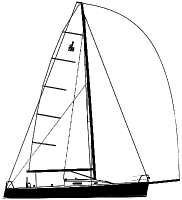J/125
Racer/cruiserr
Once again, it is all a matter of personal sailing style, but let's assume for fun that you day-sail your boat most of the time with an occasional weeklong cruise twice each summer. Saturday, Paul and I went out for a sail in his Ultimate 20. It was just the two of us but we easily handled the asymmetrical spinnaker-jibe, jibe, jibe-and blew by everything we encountered on the bay. Getting that speed with only two on board compounds the fun.
At 41 feet, the J/125 is getting to be a serious boat. You can quickly see the family resemblance to the smaller J sport boats. The 125 started its life with the same philosophy as the 24: Ignore the arbitrary rules laid down by committees. Most noteworthy of this boat's features is its narrow shape. The argument goes on and on, but I'm a firm believer in narrow boats. They are generally well-mannered and fast. The trick is to gain your stability needs through keel configuration, then you can reduce beam to reduce drag. Beam for its own sake is always slow.
The J/125 gets its stability through the 8-foot-draft fin keel. The upper portion of this keel, the strut, is a cast nickel/bronze/aluminum alloy. The bulb portion is lead. Mars Metal casts the lead bulb directly onto the keel strut. Coupling this keel with very lightweight construction results in a low vertical center of gravity.
The stability issue may hold the key to the potential success of this design. We all like to sail fast but we donÕt like to sail having to constantly compromise our trim to optimize stability. ItÕs also not very convenient to need a crew of 10 on a 40-footer just to keep the boat on its feet. The spectre of a knockdown is not conducive to leisurely cruising. "Have you seen the dog, dear?"
The 125 has an overall VCG 2.4 feet below the DWL. This is phenomenally low and, with the narrow beam, translates to a limit of positive stability of 141 degrees, according to the current IMS certificate. This means that I could put the chute up with my wife as crew and push the boat to the limit without being concerned about stability. IsnÕt that why we sail keelboats? It doesnÕt take water ballast to do this and, in the bigger picture, water ballast may be more a component of the problem than it is of the solution.
In terms of rig and deck, the J/125 truly has a big dinghy-type layout. The cockpit is huge, with the wheel aft and close to the traveler and mainsheet controls. A wheel makes sense but it would be fun to steer this boat with a tiller.
Using the SCRIMP lay-up process, epoxy, E-glass, Kevlar and carbon fiber, J/Boats has built a very strong and very, very light structure. The ballast-to-displacement ratio using brochure specs is 56 percent, and thatÕs unusual by todayÕs standards.
I like this boat because it's not another "me too" attempt at a big one-design. J/Boats will do its best to orchestrate strict one-design rules, but the boat itself is a breakaway from the current fleet. I'm looking forward to a ride. J/Boats, P.O. Box 90, 557 Thames St., Newport, RI 02840. (401) 846-8410, fax (401) 846-4723.
Strong, fast, breakaway one-design.

Comments